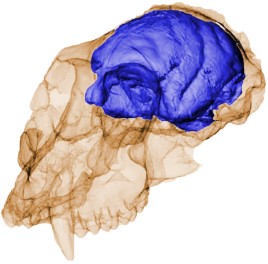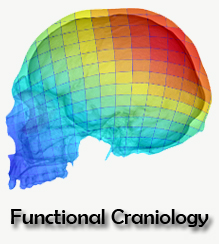Primates are unique among mammals for having a brain much larger than expected for body size. An important aim in paleoneurology is understanding how cerebral structures reorganized to accomodate primate cerebral expansion. The brain comprises only soft-tissue and does not fossilize so paleoneurologists rely on endocasts, either physical or digital molds of the cranial cavity, to estimate the macro-anatomy of the brain. Continuing computational advances and powerful imaging techniques have allowed the generation of increasingly higher-resolution digital endocasts. Gonzales et al. (2015) generated a high-resolution endocast of the 15 Myr-old fossil cercopithecine Victoriapithecus macinnesi using micro-CT scans. By using computational methods, taphonomic distortion was corrected and a new endocranial volume (ECV) of 35.6 cm3 reported for Victoriapithecus which is much smaller than the previous value 54 cm3. This new, smaller ECV places Victoriapithecus within the range of extant strepsirrhines but outside the range expected of extant and fossil cercopithecoids including the 32 Myr-old fossil species Aegyptopithecus zeuxis which had an ECV within the expected range for fossil cercopithecoids.
Despite Victoriapithecus exhibiting a very small ECV and falling below the range for extant cercopithecoids, the fossil does exhibit the ‘frog-shaped’ sulcal pattern shared only among cercopithecines. This sulcal pattern suggests Victoriapithecus is a cercopithecine, the ‘frog-shaped’ sulcal pattern is such a diagnostic trait that it is not shared by the leaf-eating colobines but only present in cercopithecines. The olfactory bulbs in Victoriapithecus are unusually large relative to the small ECV. Large olfactory bulbs are present in extant strepsirrhines and the fossil catarrhine Aegyptopithecus zeuxis but reduced in all extant and fossil cercopithecoids and hominoids. The presence of small olfactory bulbs in the 18 Myr-old hominoid Proconsul versus the large bulbs in Victoriapithecus suggested olfactory bulb reduction may have evolved independently in both cercopithecoids and hominoids.
Harrington et al. (2016) compared digital endocasts generated from micro-CT of three adapiform fossil primates including the 48 Myr-old Notharctus tenebrosus, 47 Myr-old Smilodectes gracilis and 45 Myr-old Adapis parisiensis. Results of endocranial volume (ECV) were consistent with other studies revealing an ECV of 7.6 cm3 for Notharctus, an ECV of 8.3 cm3 for Smilodectes while Adapis had an ECV of 8.8 cm3. The sulcal morphology of these adapiforms was also consistent with previous studies showing the defining feature of the primate brain, the Sylvian sulcus, is species-specific in these adapiforms. The Sylvian sulcus is well-defined in Adapis, occurs only as a shallow depression in Notharctus but is entirely lacking in Smilodectes. The absence of the Sylvian sulcus in Smilodectes is not understood but as it is absent in other mammals, this may represent a retained ancestral trait from before the divergence of primates from other mammals.
The cerebral organization of Notharctus and Smilodectes showed both possessed larger temporal and occipital lobes relative to brain size with smaller olfactory bulbs and frontal lobes. This trend might indicate cerebral reorganization favoring larger visual-auditory structures located in the temporal-occipital regions of the brain versus smaller visual-olfactory structures in the frontal region. The olfactory bulbs of these adapiforms were small and blunt relative to endocranial volume and predicted body mass but uniquely, Adapis parisiensis had the largest olfactory bulbs, placing it within the range of extant strepsirrhines. These studies reveal how little is understood about primate paleoneurology and the evolutionary trends of different primate lineages with implications for the human fossil record.
Alannah Pearson








Leave a comment